Kosher and Traditional Jewish Cooking: Authentic Recipes From a Classic Culinary Heritage: 130 Delicious Dishes Shown in 220 Stunning Photographs (46 page)
Authors: Marlena Spieler

and
pastries
For Jews, whenever there is something to celebrate, be it a festival or a family occasion, cakes and other sweet treats are very much in evidence. Precisely what is on the table will largely depend on whether the hosts come from the Ashkenazi or Sephardi traditions, as these take very different approaches when it comes to baking.
During Pesach, the kosher kitchens of both Ashkenazim and Sephardim undergo a transformation. At this time, all food must be free of leaven, and eggs are used as the main raising agent instead. The result is a wealth of featherlight sponge cakes, often made with matzo meal and ground nuts.
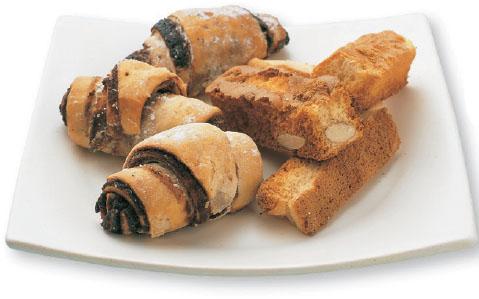
Traditional Ashkenazi rugelach and mandelbrot cookies are delicious with a glass of hot tea.
Visit an Eastern European bakery and you will find the shelves filled with a wide selection of delectable pastries, sweetmeats, crisp cookies, cakes and crunchy rolls. No one could possibly walk through without having a “little something”. A cup of coffee is never just a cup of coffee: you must have a Danish – a pastry filled with jam and topped with icing (frosting) – or a rugelach, or maybe a mohn cake or strudel, or perhaps an apfelkuchen. The choice and variety is endless.
Cakes of all kinds are baked in the Ashkenazi kitchen. Kuchen is closer to a sweet fruit bread than a cake. It is made from a sweet dough, filled with fresh or dried fruit. Honey cake, also known as lekach, is eaten for Rosh Hashanah and Shabbat, while almond cakes, plava and other leaven-free cakes are classic Pesach specialities. For Purim, the traditional treat is hamantashen, triangular cakes filled with seeds and fruit.
Cookies and sweet biscuits include croissant-shaped rugelach, almond mandelbrot and plain kichel. None of these are very sweet, and they make the perfect accompaniment to tea. Teiglach, from Lithuania, are rich with honey, so a little goes a long way.
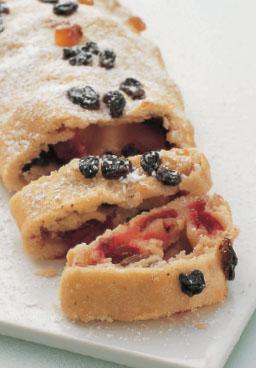
Sweet, fruit-filled strudel made with paper-thin pastry is one of the glories of the Eastern European Jews.
Candied orange peel, known as pomerantzen, is a great favourite of all Jews, not just because it tastes so good, but because the peel that might otherwise have been discarded is transformed into an irresistible treat.
Jews love pastries, the most well known being strudel, which originated as a hefty pastry roll filled with vegetables or fruit. It was the Turks, invading Hungary in 1526, who introduced the very thin multilayered pastry that we now know as strudel dough.
Strudel is eaten for many festivals: with cabbage for Simchat Torah; with dried fruit for Tu b’Shevat; with crushed poppy-seed paste for Purim and with cheese for Shavuot. Fruit versions are filled with sliced apple, cherries or rhubarb, alone or with dried fruit.
This is very like filo pastry, which can be bought ready-made and makes a good substitute for strudel pastry.
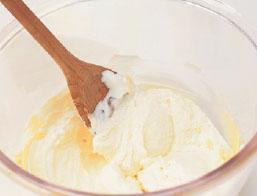
1
In a bowl, beat 250g/9oz/generous 1 cup butter with 30ml/2 tbsp sugar and 250ml/8fl oz/1 cup sour cream or softened vanilla ice cream. Add 2.5ml/
1
/
2
tsp vanilla extract and 1.5ml/
1
/
4
tsp salt, then stir in 500g/1
1
/
4
lb/5 cups plain (all-purpose) flour. Mix to a soft dough.
2
Divide the dough into three pieces, wrap separately and chill overnight (or freeze for up to 3 months).
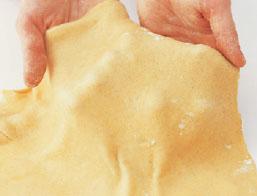
3
If necessary, thaw the dough. Place one piece on a floured board. Flatten it lightly, then, very gently, pull it out with your hands, pulling each side in turn until it is almost paper thin. It is now ready to fill and bake.
These are Mediterranean in their origin. Every Sephardi community produces a wealth of moist, succulent almond and walnut cakes. Often a local dish was adapted for Jewish holidays – Greek Jews eat crisp, fried loukomades for Chanukkah, Israelis eat jam-filled sufganiot (doughnuts) and Tunisians enjoy syrup-soaked cakes for Purim.
During Pesach, when leaven may not be used, many cookies and cakes are made with nuts. Almond cakes, coconut macaroons and sesame seed halva are favourites.
Syrup-soaked filo pastries, such as baklava, are popular among Sephardi Jews. Other pastries include kaddaif, a shredded pastry drenched in syrup, and felabis, deep-fried, pretzel-like pastries filled with syrup.
The secret to perfect baklava is to pour very cold syrup over a hot pastry, or very hot syrup over a cold pastry.
1
Preheat the oven to 200ºC/400ºF/Gas 6. Layer six sheets of filo pastry in a shallow ovenproof dish, brushing each layer with melted butter or oil.
2
Sprinkle chopped nuts on top of the pastry, to a depth of 1cm/
1
/
2
in.
3
Sprinkle generously with sugar and cinnamon. Top with six more layers of buttered or oiled filo, then cut the top layer of pastry into triangles.
4
Bake for 30 minutes until golden. Remove from the oven and pour over hattar, or a light syrup flavoured with orange flower water or rose water.
This is one of the most popular desserts in the deli cabinet. It is often associated with Ashkenazim from Germany, who were famous for their fresh cheeses. It is eaten at Shavuot, reflecting the legend of the Jews who, on returning to camp after receiving the Torah, found that their milk had turned sour and had to sweeten it with honey.
Cheesecakes can be flavoured and topped with many ingredients from fruit to chocolate and it is not unusual to find delis offering upwards of 30 different types.
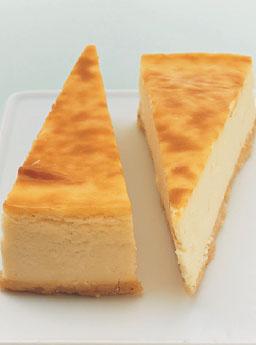
Cheesecake is a deli classic, though purists argue that only a simple white cheesecake can be considered the real thing.
BAGELS
Bread rolls with a hole in the middle, symbolizing the circle of life. They are boiled before being baked.
BAKLAVA
A crisp pastry of filo and nuts soaked in a honey syrup, which is often flavoured with rose or orange flower water or sweet spices.
BAR/BAT MITZVAH
The coming of age ceremony for a boy (bar) or girl (bat) in which they assume the religious duties and responsibilities of an adult. A boy reaches this age at 13 years old, a girl at 12 years old.
BESAN
See gram flour.
BETZA/BEITZAH/BAITZAH
Hebrew for egg. Betza are eaten by all Jewish communities and are considered
pareve;
they play an important role in the ritual plate for the Pesach Seder.
BLINTZ
A thin pancake rolled around a savoury or sweet filling. They are often fried.
BORSCHT
Soup of Ashkenazi origins made from beetroot (beet) and sometimes other vegetables; eaten hot or cold.
BOTARGA
Sephardi salted or smoked dried fish roe such as sea bass and grey mullet.
BRIK
A deep-fried Moroccan-Tunisian pastry made from warka dough. Tuna and egg is a very popular filling.
CHANUKKAH
The festival of lights commemorating the Maccabean victory over the Seleucians in 165
BCE
(
BC
). Also known as Hanukkah.
CHAROSSES/CHAROSSET
The paste of nuts, spices, wine and fruit eaten at Pesach to symbolize the mortar used by the Jews to build the pyramids. Also known as Harosset.
CHASSIDIM
A movement of Observant Jews originating in Poland, the Ukraine and Galicia.
CHELLOU
Persian rice, cooked with butter and allowed to form a crisp bottom crust. Vegetables, herbs, fruits and nuts may be added.
CHERMOULA
A Moroccan spice and herb paste, often used with fish.
CHICKPEA FLOUR
See gram flour.